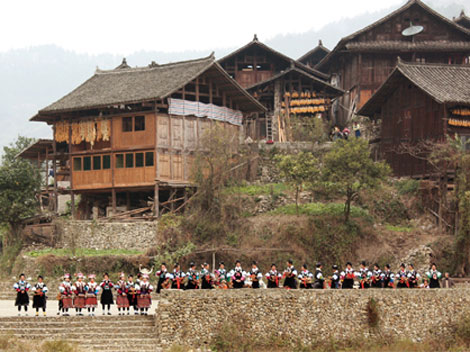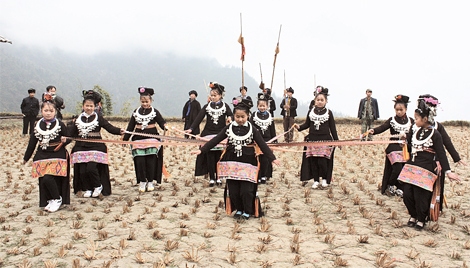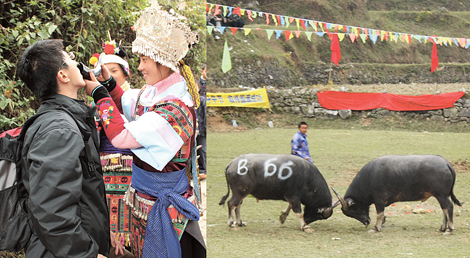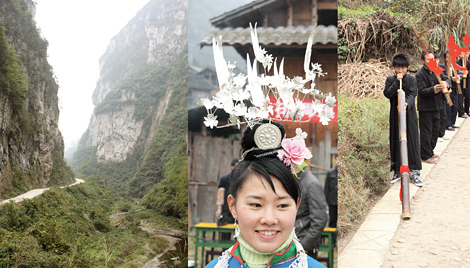
Villagers of the Miao ethnic minority celebrate Miao's New Year in front of their houses built on the mountainside in Danzhai County, Guizhou Province. Their seclusion in the mountains helps the villagers sustain their traditional culture against the prevailing Han culture.
Many foreigners are fascinated by the various Chinese New Year activities. But as a native Han Chinese, I have recently been captivated by the splendid New Year of the Miao ethnic minority.
The seclusion in the mountains helps those Miao villages in Danzhai County, Guizhou Province, take refuge from being assimilated by the prevailing Han culture. Many of their customs survive and remain intact.
Danzhai, in Guizhou's southeast, is under the jurisdiction of the Qiandongnan Miao and Dong Autonomous Prefecture. Multiple ethnic minorities are domiciled in Danzhai, and Miao people comprise the county's dominant population, accounting for nearly 80 percent of the total.
Miao's New Year, which is the most important yearly festival for the Miao minority, usually starts in early or mid November when they finish one year's farm work.
One or two Miao villages raise the curtain for New Year celebrations, says our tour guide surnamed Zhou, a Danzhai Miao native. They will invite nearby villagers to join them to enjoy the harvest and share the delight.
The revelling will last for months and pass on between Miao villages in the county one by one, Zhou says. The last village will not end their celebration until early next year -- usually February or March -- when they will start spring plowing, she says.

Miao girls move into formation to form a big pheasant while performing the Jinji Dance to celebrate Miao’s New Year. Danzhai County is famous for the Jinji Dance, or “Dance of the Golden Pheasant,” one of many renditions of Miao folk dancing.
Wine is always used to show the hospitality of the hosts and Miao people have their own special way to welcome guests. Young Miao women, in gorgeous traditional costumes, will stand in two or three lines at the gate or entrance to their village with homemade rice wines in hand.
The women will hand rice wine -- held in the common container of cattle horns -- to guests as part of the greeting. You should sip the rice wine, without touching the horn. If you touch it, the pretty Miao woman will hand over the horn and you must drink it "bottoms up." Ganbei!
One sip can get you get through only the front line of the salutation line-up. The second and third lines will each have a woman ready to give you another drink. When you manage to pass the "rice wine test" of the three lines you can enter the village.
I am not a big fan of rice wine, but when in Rome, do as the Romans do. Fortunately, the rice wine was not too harsh for me, despite being homemade. It tasted a bit sweet. Soon I found the reception a really effective way to make guests feel warm as the weather was quite chilly in Guizhou in November. But as well as the rice wine, I was intoxicated by the cordial smiles, hospitality and friendliness the Miao villagers poured into my heart.
Along with the women, male Miao villagers blow lusheng and mangtong, both Miao folk instruments, to make music.
Dancing is definitely something you should not miss, especially for Miao, an ethnic group well versed in singing and dancing.
Danzhai is famous for Jinji Dance, or "Dance of the Golden Pheasant," one kind of Miao folk dancing. Maniao Village, in the county's Yahui Township, is considered the birthplace of Jinji Dance.
Yahui means villages above the clouds in Miao language and Maniao's solitary location is a good explanation of the definition.

Left: A Miao woman, in traditional costume, feeds a guest at the village gate with rice wine from a cattle horn, one of the Miao people’s special way of welcoming guests. Right: Two bulls drop their heads and lock horns, each waiting for the other to give in. Bullfighting is another tradition in Miao New Year celebrations.
I saw the bus wind its way through the mist in the mountains. After a three-hour bumpy ride from the Danzhai county seat, we arrived and saw clouds beneath our feet in the valley.
The dancing was staged in the farm field, which becomes the villagers' playground in winter.
Scores of villagers danced like fluttering pheasants in the field. They leapt, spun, bent and extended their bodies to imitate pheasant moves to the sounds of the music. Sometimes they joined hands to form circles or lines, sometimes they gathered to shape a big pheasant.
Despite similar overall appearance, the traditional Miao costumes are very different in detail between villages in Danzhai, with variations in colors, clothing patterns and headgear.
Silvery headgear is the most awe-inspiring ornament in a Miao costume, and Maniao villagers' headgear has a unique feature. There are several pheasants on the headgear and when the wearer dances, the pheasants wave the long tails and shake their heads in the air, adding more glamor to the performance.
Bullfighting is another tradition in Miao New Year celebrations. Different from the well-known Spanish spectacle pitting man against beast, the Miao bullfight is a battle between bulls.
Our visit to Yanglang Village coincided with a bullfight competition and the participation of bulls from nearby villages made almost all the villagers turn out to watch.

Left: A path winds its way through a valley where young Miao men and women in love sing songs to express their affection for each other. It is also called “ lovers’ valley” by local villagers. Middle: A woman from Maniao Village shows off her silvery headgear, featuring several pheasants, which add glamour when the wearer performs a traditional dance. Right: Male Miao villagers blow lusheng and mangtong, both Miao folk musical instruments, to welcome guests.
The bulls appear obedient when led by their owners to the battlefield. But upon seeing their opponents, they turn fiery and uncontrollable.
In the first contest, two unleashed bulls ran onto the battlefield and rushed toward each other. The head-to-head collision shocked every spectator but then the fight moved into a quieter stage. They dropped their heads and locked horns, each waiting for the other to give in.
After several minutes' tug of war, one bull began struggling to hold its ground. He stepped backwards. Seconds later, he gave up and ran away. He lost.
The loser was taken home, leaving the winner to receive the cheers and applause.
In another contest, neither of the two bulls showed any sign of backing down so the referee judged it a draw. But it was tough to stop them.
After using a rope to bind one of the hind legs of each bull, more than 10 young men on each side had to use all their strength to separate the locked beasts.
The bullfights can last a full day or even longer until the champion is decided. Villagers say the later bullfights could be more exciting, as slight injuries could stir the bulls' spirits.
Besides sipping the essence of Miao culture, other aspects of the area helped me escape the giddy urban life of the city. They included seeing terraced fields in the mountain breeze and walking in the valleys where young lovers from Miao villages sing songs to express their affection for each other.





